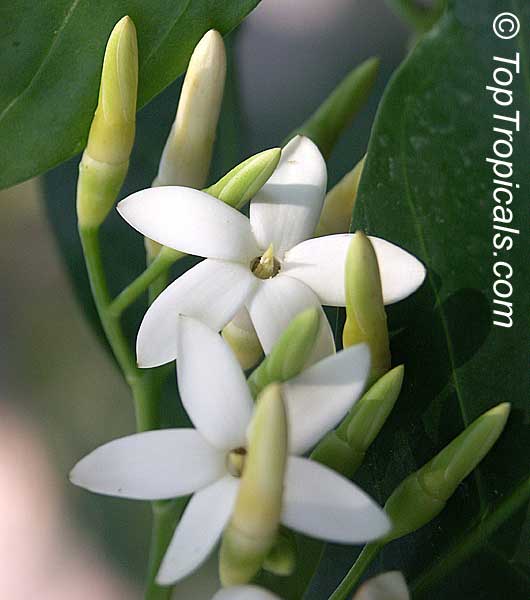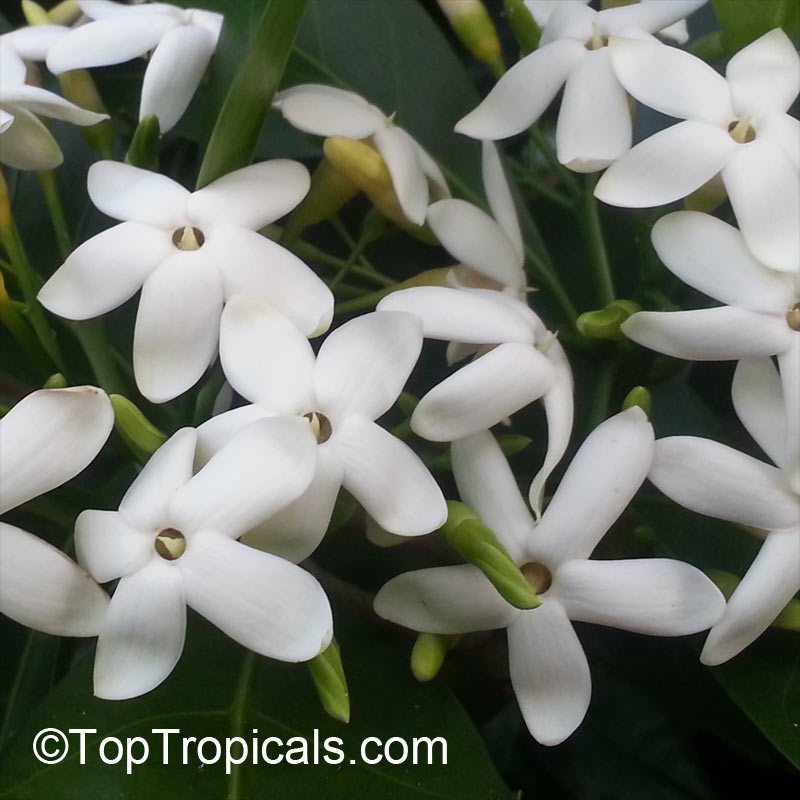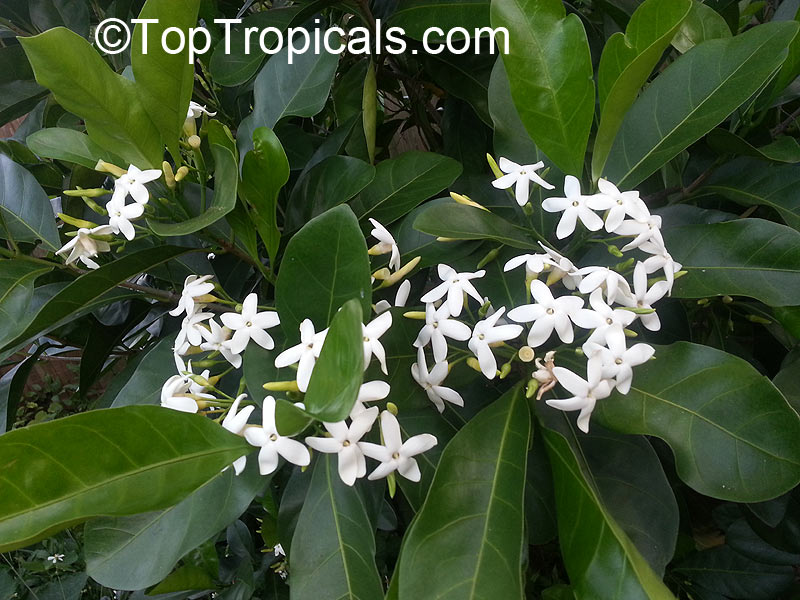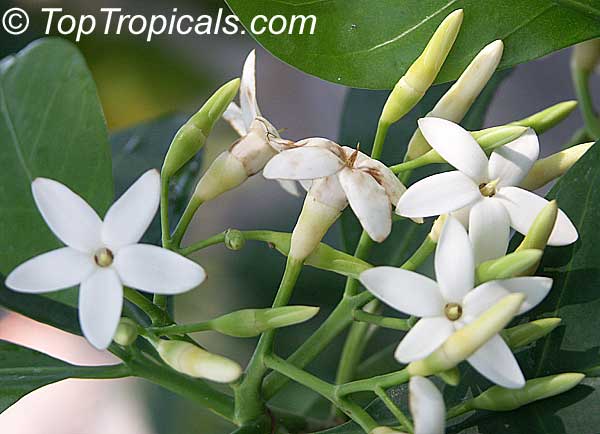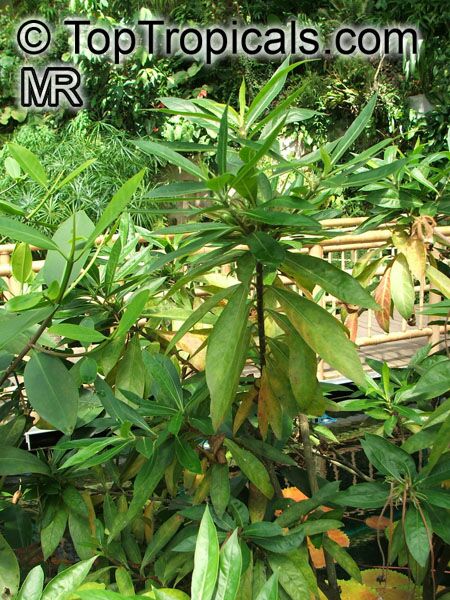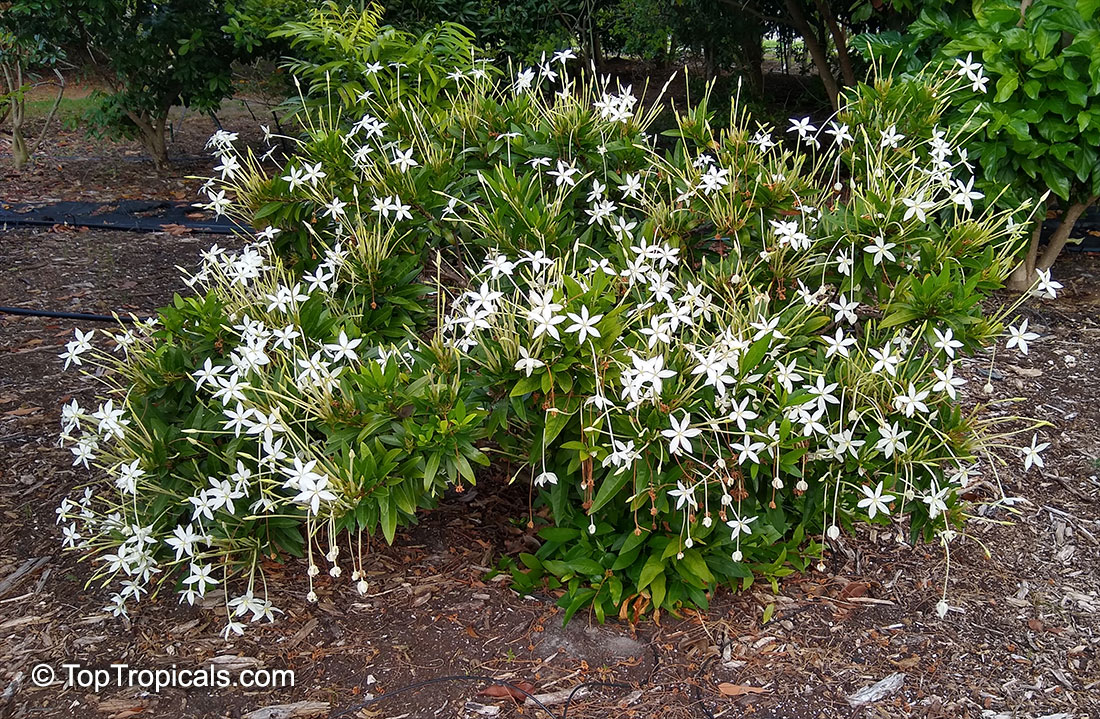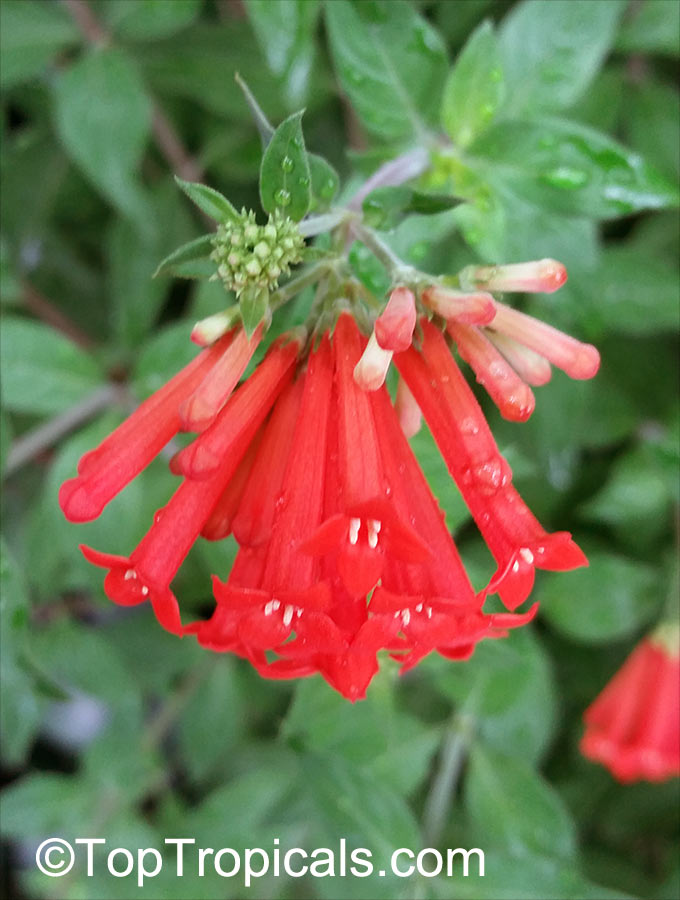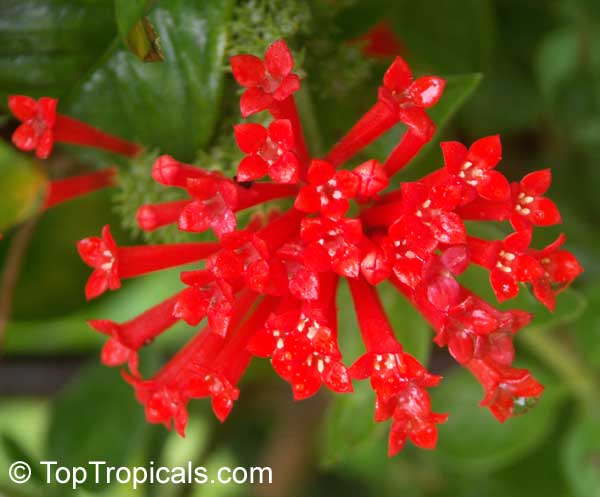Rubiaceae - Botanical Family
Top Tropicals Plant Encyclopedia
| Number of plants found: 178 | Next | 
|
Go to page: | 1 | 2 | 3 | 4 | 5 | Last |
Botanical name: Alberta magna
Common name: Natal flame bush
Family: Rubiaceae
Origin: South Africa





The Albertia manga's glossy leaves, brilliant flowers, and fruits, makes this is an aristocrat in gardens. It grows best in areas with moist climates,but doesn't like to be in areas with dry heat or cold temperatures.The Albertia manga is usually slow growing, but it will flower while still small.
Botanical names: Atractocarpus fitzalanii, Randia fitzalanii, Gardenia fitzalanii
Common names: Native Gardenia, Yellow Mangosteen
Family: Rubiaceae
Origin: Australia, Tropical Asia










Small tree, usually only to 10-20ft. tree with large, glossy green leaves. The white flowers have a gardenia-like perfume. Enjoys moist, warm environment of Rainforest. Dark shining foliage sets off these beautifully fragrant spring flowers. They are star-shaped and come in clusters. In late autumn, yellow skinned fruits develop, 2"-4" in diameter, filled with small seeds embedded in soft pulp, with a flavor resembling a mangosteen. Dense, shiny foliage, the leaves are large, dark green and glossy. Very tropical looking plant, rare in cultivation.
Botanical name: Augusta rivalis
Common names: Marmelada, Purui, Trompito, Madrono, Zumbo, Guayabito de monte, Star of Belize, Alibertia
Family: Rubiaceae
Origin: Amazon River Region, Brazil










Ornamental alibertias have large slightly fragrant flowers, similar to some gardenias or keilarsenia. It is a beautiful landscape shrub that can be used for small gardens or containers. The plants bloom profisely through summer, and are easy to take care of.
One of the species is a fruit tree - Alibertia edulis. It is a small erect tree, usually only to 10-15ft high. Flowers are white, large and slightly fragrant, followed by a green fruit, similar in size and shape to the pomegranate. Its black pulp is said to resemble marmelade and quinces. Eaten fresh out of hand, or used to make jellies and sweets.
It prefers filtered light and can tolerate shade - this is a great choice of flowering showy plant for shaded areas!
Recommended Fertilizer: SUNSHINE Megaflor - Bloom Nutrition Booster
Last one
Botanical name: Borojoa patinoi
Common name: Borojo
Family: Rubiaceae
Origin: Amazonia and Central America






Growing Borojo (Borojoa patinoi) is best done in USDA Zones 9-11, with an ideal temperature of 75-80F and humidity of 85%. The Borojo tree prefers semi-shade but can tolerate full sunlight as well. It has a slow growth rate, reaching heights of 10-20 feet, and should be watered regularly. The Borojo produces white to off-white flowers when mature, which produce the small fruits which are highly sought after.
Borojo fruits contain many beneficial vitamins and minerals, which are used within traditional ethnomedical practices. In traditional cuisine, the Borojo fruit is made into juices, compotes, marmalades, candies and wine. Aside from its ethnomedical practices, it is also very nutritious and considered an aphrodisiac and its juice is called jugo del amor. Borojo has one of the highest levels of water soluble B vitamins among fruits.
Botanical names: Bouvardia longiflora, Bouvardia humboldtii
Common name: Scented Bouvardia
Family: Rubiaceae
Origin: Americas






Bouvardia longiflora, commonly known as the Scented Bouvardia is native to the Americas. This lovely large shrub can reach heights of 5 to 10 feet tall while its smaller cousin can reach heights of 2 to 5 feet. You will find many off-white and white flowers that have a sweet and delicate fragrance throughout the growing season.
In order to make sure your Bouvardia longiflora look its best and continues to produce fragrant blooms, here are some tips for growing and keeping it healthy:
Provide your Bouvardia longiflora with a bright space that gets at least six hours of indirect light each day. They prefer a semi-shaded area and it is important to protect from direct sunlight.
Water your Bouvardia longiflora regularly, but be careful not to over-water. During the winter months, water less frequently but make sure it never dries out completely. They enjoy humid climates, so misting the foliage each morning might be beneficial.
When planting your Bouvardia longiflora in colder regions, it is important to provide protection from winter frosts and low temperatures. Planting in containers and adding mulch is a great way to give them some warmth while still allowing proper drainage.
With proper care and attention, your Bouvardia longiflora will provide you with a beautiful, fragrant display and long blooming season each year.
Botanical name: Bouvardia ternifolia
Common names: Scarlet Bourvardia, Trumpetilla, Firecracker Bush, Hummingbird Flower
Family: Rubiaceae
Origin: Arizona, New Mexico and Mexico, down to Central America









In cooler climates, Bouvardia ternifolia (Scarlet Bourvardia) should be grown in pots and brought indoors before the cold weather arrives. Plant in well-draining, lightly acidic soil and place it in an area that gets a minimum of 4-6 hours of direct sunlight a day. Water regularly while the plant is actively growing and reduce watering in the winter or when the plant is dormant. When growing in a pot, it is best to repot every 2 to 3 years, as the growth rate of this small shrub is quite fast. In USDA Zones 9-11, the mature plant can manage temperatures as low as 30°F for a short time, but it is advised to give it extra protection with mulch or frost blankets if the cold weather will last longer than usual.
Whether you are looking to add some color to an outdoor patio, a terrace, or a balcony, Bouvardia ternifolia
will be an excellent choice. The bright, red, crimson and vinous flowers of this small shrub are extremely fragrant and will attract butterflies and hummingbirds during the day. Keep in mind that it will need regular water, plenty of sunlight and some protection from the frost during the cold season, and you will be able to enjoy its beauty for many years to come.
Botanical name: Burchellia bubalina
Common names: Wild Pomegranate, Wildegranaat, Buffalo Wood, Buffalo Horn
Family: Rubiaceae
Origin: South Africa, Natal








Burchellia bubalina (Wild pomegranate) is a large shrub that produces deep red and crimson vinous flowers in small clusters at the end of its branches, followed by small yellow-green berries. The plant usually grows to a height of 5-10ft, but in favorable conditions, it can reach up to 15ft or more. Its leaves emit a pleasant aromatic smell when crushed, and it attracts butterflies and hummingbirds.
The Burchellia bubalina, which is the only species in its genus, is endemic to southern Africa and native to the Cape of Good Hope. It is also known as Buffelhorn or Buffaloe-Horn due to the extreme hardness of its wood. The plant flowers in the spring or summer and requires protection from frost. Although it thrives in full sun, it can also grow in deep shade.
The Wild pomegranate is not drought tolerant, and it requires regular watering. When planted in the garden, it should be given a sunny position or semi-shade. In locations with very cold winters, it is advisable to mulch around the plant to protect it from winter temperatures. Pruning lightly after flowering and in mid-spring can keep the shrub looking tidy.
The Wild pomegranate is not related to the true pomegranate, and its common name refers to its initial resemblance when in flower. The plant has medicinal properties, and its roots are used as an emetic to cleanse the body. Additionally, roots are used with other plant parts to concoct a love charm.
Botanical name: Calycophyllum spruceanum
Common name: Capirona
Family: Rubiaceae
Origin: South America






Calycophyllum spruceanum is a canopy tree indigenous from the Amazon rainforest.
Botanical name: Capirona decorticans
Common name: Capirona
Family: Rubiaceae
Origin: Northern South America






This tree avoids lichens, fungi, epiphytes and lianas, by getting rid of its bark. Once or twice a year it sheds off its bark entirely.
Botanical name: Carphalea kirondron
Common name: Madagascan
Family: Rubiaceae
Origin: Madagascar







An example of a Rubiaceae with enlarged, unequal, colored calyx lobes, long-styled flowers.
| Next |  |
Use link to repeat this search:
https://toptropicals.com/cgi-bin/garden_catalog/cat.cgi?search_op=and&keyword_op=and&language=e&family=Rubiaceae&number=10
&no_change_lang=1&user=tt&sale=1&first=0

